
A pub is in several countries a drinking establishment licensed to serve alcoholic drinks for consumption on the premises. The term first appeared in England in the late 17th century, to differentiate private houses from those open to the public as alehouses, taverns and inns. Today, there is no strict definition, but CAMRA states a pub has four characteristics:
- is open to the public without membership or residency
- serves draught beer or cider without requiring food be consumed
- has at least one indoor area not laid out for meals
- allows drinks to be bought at a bar

Fleet Street is a street in Central London, England. It runs west to east from Temple Bar at the boundary of the Cities of London and Westminster to Ludgate Circus at the site of the London Wall and the River Fleet from which the street was named.

Pembridge is a village and civil parish in the Arrow valley in Herefordshire, England. The village is on the A44 road about 6 miles (10 km) east of Kington and 7 miles (11 km) west of Leominster. The civil parish includes the hamlets of Bearwood, Lower Bearwood, Lower Broxwood, Marston, Moorcot and Weston. The 2011 Census recorded the parish population as 1,056.

Pub names are used to identify and differentiate traditional drinking establishments. Many pubs are centuries old, and were named at a time when most of their customers were illiterate, but could recognise pub signs. The use of signage was not confined to drinking establishments. British pubs may be named after and depict anything from everyday objects, to sovereigns, aristocrats and landowners. Other names come from historic events, livery companies, occupations, sports, and craftsmen's guilds. One of the most common pub names is the Red Lion. This list contains both modern and historical examples.
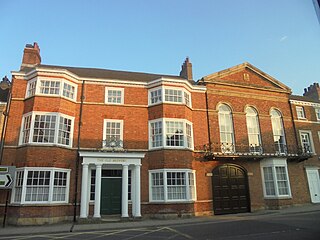
Samuel Smith Old Brewery, popularly known as Samuel Smith's or Sam Smith's, is an independent, British brewery and pub operator based in Tadcaster, North Yorkshire that traces its origins to 1758, and claims to be Yorkshire's oldest brewery.
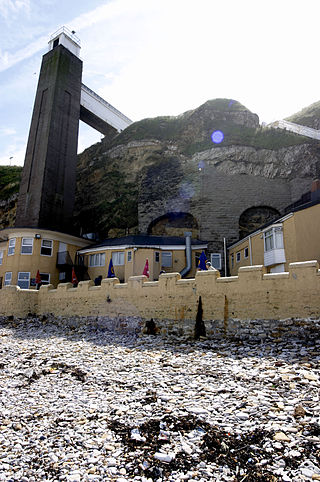
The Marsden Grotto, locally known as The Grotto, is a gastropub located on the coast at Marsden in South Shields, Tyne & Wear, England. It is partly dug into the cliff face and fronted with a more conventional building opening onto the beach. The pub is one of the very few "cave bars" in Europe, another being Ye Olde Trip to Jerusalem in Nottingham.

Ye Olde Fighting Cocks is a public house in St Albans, Hertfordshire, England. It is one of several pubs that lay claim to being the oldest in England, claiming to have been in business since 793 AD. The pub was once recognized as the oldest in England by the Guinness World Records, but the record was withdrawn from consideration in 2000 because it was deemed impossible to verify.
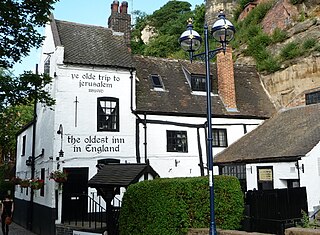
Ye Olde Trip to Jerusalem is a Grade II listed public house in Nottingham which claims to have been established in 1189, although there is no documentation to verify this date. The building rests against Castle Rock, upon which Nottingham Castle is built, and is attached to several caves, carved out of the soft sandstone. These were reputedly originally used as a brewhouse for the castle, dating from the medieval period.
Holywell is a village in Cambridgeshire, England, approximately 6 miles (10 km) east of Huntingdon, in the civil parish of Holywell-cum-Needingworth. It is situated within Huntingdonshire, a non-metropolitan district of Cambridgeshire, and is a historic county of England.

Ye Olde Man & Scythe is a public house on Churchgate in Bolton, England. The earliest recorded mention of its name is in a charter from 1251, making it one of the ten oldest public houses in Britain and the oldest in Bolton. The present form of the name, prefixed with "Ye Olde", is a pseudoarchaism derived from the Man and Scythe Inn; it derives from the crest of the Pilkington family, which consists of a reaper using a scythe, alluding to a tradition about one of the early members of the family.
The National Pub of the Year is an annual competition held by CAMRA, the winner of which is announced in the February of the year following that in which the competition is run, that finds the best pub in the UK. Established in 1988, the competition helps to highlight quality pubs around the UK that are worth seeking out and visiting. Each year, each local CAMRA branch nominates one pub in their area to be entered. These 200 pubs then go through to the regional competition, which then whittles down to 4 pubs to go to the national final.

Ye Olde Salutation Inn is a Grade II listed public house, with parts dating from around 1240, which lays claim to being the oldest pub in Nottingham. The inn also has a claim to being the most haunted pub in the country, one landlord having asserted the presence of 89 resident apparitions. Aside from these claims, it is best known locally for its rock music and has been described by local historian Dave Mooney as "an old fashioned rock and bike pub."
The Nottingham Caves Survey was a research project the aim of which was to scan every accessible cave from the 700+ man-made sandstone caves that are known to be present in the city of Nottingham. It was conducted by Trent and Peak Archaeology, at the University of Nottingham. It was managed by Dr David Strange-Walker with Julia Clarke, with documentary research undertaken by Scott Lomax. The project was funded primarily by both the Greater Nottingham Partnership, who have an interest in utilising the caves for increasing tourism and helping grow the local economy, and English Heritage, who are motivated by an interest in preserving the remaining heritage of Nottingham.

The Olde Bell inn, also known as Ye Olde Bell, is a Grade II listed historical inn in Rye, East Sussex. It was built in 1390. It has a turbulent history and was once used for smuggling, connected by a secret tunnel with the nearby Mermaid Inn to the south. It was used by the infamous Hawkhurst Gang in the 1730s and 1740s who moved goods along the tunnel from the Mermaid to a revolving cupboard in the Old Bell for a quick getaway. The inn has two separate bar areas with original oak beams and a terrace with an 80-year-old Wysteria tree.
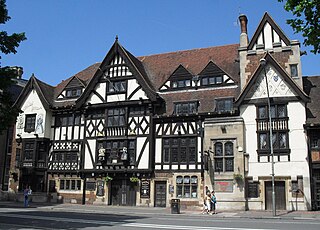
The King and Queen is a pub in the seaside resort of Brighton, part of the city of Brighton and Hove. The present building, a "striking" architectural "pantomime" by the prolific local firm Clayton & Black, dates from the 1930s, but a pub of this name has stood on the site since 1860—making it one of the first developments beyond the boundaries of the ancient village. This 18th-century pub was, in turn, converted from a former farmhouse. Built using materials characteristic of 16th-century Vernacular architecture, the pub is in the Mock Tudor style and has a wide range of extravagant decorative features inside and outside—contrasting with the simple design of the neighbouring offices at 20–22 Marlborough Place, designed a year later. English Heritage has listed the pub at Grade II for its architectural and historical importance.

Ye Olde Dolphin Inne is a Grade II listed pub, on Queen Street, in the city of Derby, England.

The Mitre Inn is a public house at 58 High Street, Chipping Barnet, London. It was established by 1633 and is probably the oldest remaining of the town's once numerous coaching inns. It is a grade II listed building with Historic England and is currently styled "Ye Olde Mitre Inne".

Ye Olde Rovers Return was a public house in the Withy Grove area of Manchester, England, constructed in the early-14th century. Demolished in 1958, it was the inspiration for the fictional Rovers Return Inn featured in the long-running British soap opera Coronation Street, first broadcast in 1960.
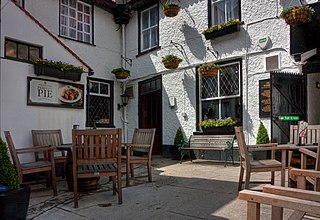
Ye Olde Starre Inne is a pub in the city centre of York, in England. The main block of the pub is a timber-framed structure, constructed in the mid-16th century, and a wing to its left was added in about 1600. By 1644, it was an inn named "The Starre", the buildings lying at the back of a coaching yard, off the north side of Stonegate. This makes it the pub in York which can demonstrate the earliest date for its licence. After the Battle of Marston Moor the inn was used as a hospital for wounded soldiers.



















